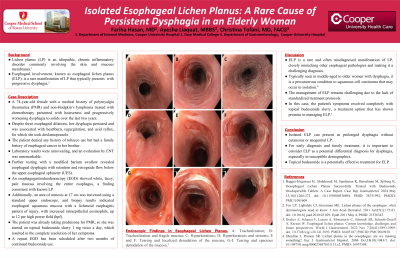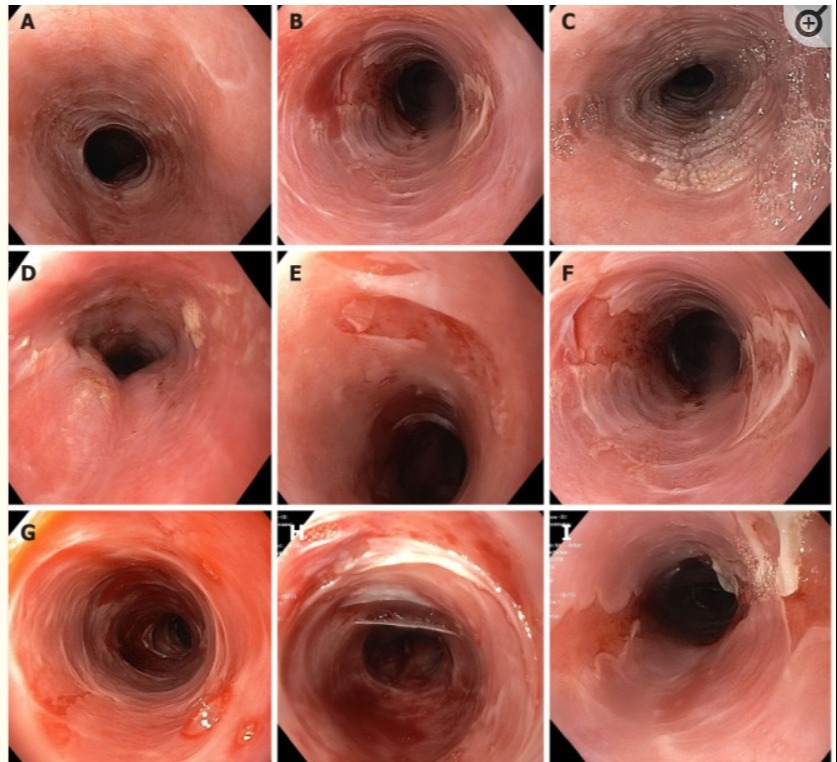Sunday Poster Session
Category: Esophagus
P0575 - Isolated Esophageal Lichen Planus: A Rare Cause of Persistent Dysphagia in an Elderly Woman
Sunday, October 27, 2024
3:30 PM - 7:00 PM ET
Location: Exhibit Hall E

Has Audio

Fariha Hasan, MD
Cooper University Hospital
Philadelphia, PA
Presenting Author(s)
Fariha Hasan, MD1, Ayesha Liaquat, MBBS2, Christina Tofani, MD, FACG3
1Cooper University Hospital, Philadelphia, PA; 2Dow Medical College, Karachi, Sindh, Pakistan; 3Digestive Health Institute at Cooper University Hospital, Camden, NJ
Introduction: Lichen planus (LP) is an idiopathic, chronic inflammatory disorder commonly involving the skin and mucous membranes. Esophageal involvement, known as esophageal lichen planus (ELP), is a rare manifestation of LP typically presenting with progressive dysphagia. ELP can significantly impact a patient's quality of life because of its gradual onset and potential complications like esophageal strictures and mucosal damage. We report a rare case of isolated ELP in an elderly woman presenting with prolonged dysphagia, without cutaneous or anogenital LP, treated with budesonide.
Case Description/Methods: A 74-year-old female with a medical history of polymyalgia rheumatica (PMR) and non-Hodgkin’s lymphoma treated with chemotherapy presented with hoarseness and progressively worsening dysphagia to solids over the last two years. Despite three esophageal dilations, her dysphagia persisted and was associated with heartburn, regurgitation, and acid reflux, for which she took dexlansoprazole. The patient denied any history of tobacco use but had a family history of esophageal cancer in her brother. Laboratory results were unrevealing, and an evaluation by ENT was unremarkable. Further testing with a modified barium swallow revealed esophageal dysphagia with retention and retrograde flow below the upper esophageal sphincter (UES). An esophagogastroduodenoscopy (EGD) showed white, lacey, pale mucosa involving the entire esophagus, a finding consistent with known LP. Additionally, an area of stenosis at 17 cm was traversed using a standard upper endoscope, and biopsy results indicated esophageal squamous mucosa with a lichenoid esophagitis pattern of injury, with increased intraepithelial eosinophils, up to 12 per high power field (hpf). The patient was already taking prednisone for PMR, so she was started on topical budesonide slurry 1 mg twice a day, which resulted in the complete resolution of her symptoms. A repeat EGD has been scheduled after two months of continued budesonide use.
Discussion: ELP is a rare and often misdiagnosed manifestation of LP, closely mimicking other esophageal pathologies and making it a challenging diagnosis. Typically seen in middle-aged to older women with dysphagia, it is a precancerous condition to squamous cell carcinoma that may occur in isolation. Our case highlights the importance of considering ELP as a potential differential diagnosis for dysphagia, especially in susceptible demographics, which is crucial for early diagnosis and timely treatment.

Disclosures:
Fariha Hasan, MD1, Ayesha Liaquat, MBBS2, Christina Tofani, MD, FACG3. P0575 - Isolated Esophageal Lichen Planus: A Rare Cause of Persistent Dysphagia in an Elderly Woman, ACG 2024 Annual Scientific Meeting Abstracts. Philadelphia, PA: American College of Gastroenterology.
1Cooper University Hospital, Philadelphia, PA; 2Dow Medical College, Karachi, Sindh, Pakistan; 3Digestive Health Institute at Cooper University Hospital, Camden, NJ
Introduction: Lichen planus (LP) is an idiopathic, chronic inflammatory disorder commonly involving the skin and mucous membranes. Esophageal involvement, known as esophageal lichen planus (ELP), is a rare manifestation of LP typically presenting with progressive dysphagia. ELP can significantly impact a patient's quality of life because of its gradual onset and potential complications like esophageal strictures and mucosal damage. We report a rare case of isolated ELP in an elderly woman presenting with prolonged dysphagia, without cutaneous or anogenital LP, treated with budesonide.
Case Description/Methods: A 74-year-old female with a medical history of polymyalgia rheumatica (PMR) and non-Hodgkin’s lymphoma treated with chemotherapy presented with hoarseness and progressively worsening dysphagia to solids over the last two years. Despite three esophageal dilations, her dysphagia persisted and was associated with heartburn, regurgitation, and acid reflux, for which she took dexlansoprazole. The patient denied any history of tobacco use but had a family history of esophageal cancer in her brother. Laboratory results were unrevealing, and an evaluation by ENT was unremarkable. Further testing with a modified barium swallow revealed esophageal dysphagia with retention and retrograde flow below the upper esophageal sphincter (UES). An esophagogastroduodenoscopy (EGD) showed white, lacey, pale mucosa involving the entire esophagus, a finding consistent with known LP. Additionally, an area of stenosis at 17 cm was traversed using a standard upper endoscope, and biopsy results indicated esophageal squamous mucosa with a lichenoid esophagitis pattern of injury, with increased intraepithelial eosinophils, up to 12 per high power field (hpf). The patient was already taking prednisone for PMR, so she was started on topical budesonide slurry 1 mg twice a day, which resulted in the complete resolution of her symptoms. A repeat EGD has been scheduled after two months of continued budesonide use.
Discussion: ELP is a rare and often misdiagnosed manifestation of LP, closely mimicking other esophageal pathologies and making it a challenging diagnosis. Typically seen in middle-aged to older women with dysphagia, it is a precancerous condition to squamous cell carcinoma that may occur in isolation. Our case highlights the importance of considering ELP as a potential differential diagnosis for dysphagia, especially in susceptible demographics, which is crucial for early diagnosis and timely treatment.

Figure: Endoscopic findings in esophageal lichen planus. A: Trachealization; B: Trachealization and fragile mucosa; C: Hyperkeratosis; D: Hyperkeratosis and stenosis; E and F: Tearing and localized denudation of the mucosa; G-I: Tearing and spacious denudation of the mucosa.
Decker A, Schauer F, Lazaro A, Monasterio C, Schmidt AR, Schmitt-Graeff A, Kreisel W. Esophageal lichen planus: Current knowledge, challenges and future perspectives. World J Gastroenterol. 2022 Nov 7;28(41):5893-5909. doi: 10.3748/wjg.v28.i41.5893. PMID: 36405107; PMCID: PMC9669830.
Decker A, Schauer F, Lazaro A, Monasterio C, Schmidt AR, Schmitt-Graeff A, Kreisel W. Esophageal lichen planus: Current knowledge, challenges and future perspectives. World J Gastroenterol. 2022 Nov 7;28(41):5893-5909. doi: 10.3748/wjg.v28.i41.5893. PMID: 36405107; PMCID: PMC9669830.
Disclosures:
Fariha Hasan indicated no relevant financial relationships.
Ayesha Liaquat indicated no relevant financial relationships.
Christina Tofani indicated no relevant financial relationships.
Fariha Hasan, MD1, Ayesha Liaquat, MBBS2, Christina Tofani, MD, FACG3. P0575 - Isolated Esophageal Lichen Planus: A Rare Cause of Persistent Dysphagia in an Elderly Woman, ACG 2024 Annual Scientific Meeting Abstracts. Philadelphia, PA: American College of Gastroenterology.
